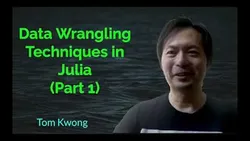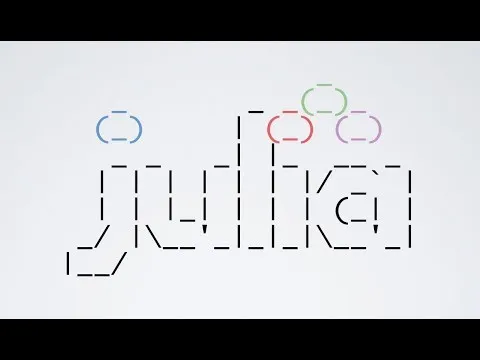
Data Wrangling Techniques in Julia - Part 1 Tom Kwong 
Data wrangling is the process of transforming raw data into a usable format for analysis. Tom Kwong's course, Data Wrangling Techniques in Julia - Part 1, covers the Julia data ecosystem and the five-step workflow of data wrangling: reading, cleaning, tidying, analyzing, and visualizing. Through this course, participants will gain the skills to effectively wrangle data in Julia. ▼
ADVERTISEMENT
Course Feature
![]() Cost:
Cost:
Free
![]() Provider:
Provider:
Youtube
![]() Certificate:
Certificate:
Paid Certification
![]() Language:
Language:
English
![]() Start Date:
Start Date:
On-Demand
Course Overview
❗The content presented here is sourced directly from Youtube platform. For comprehensive course details, including enrollment information, simply click on the 'Go to class' link on our website.
Updated in [February 21st, 2023]
What is data wrangling?.
Julia's data ecosystem .
Data wrangling workflow: Read.
Data wrangling workflow: Clean.
Data wrangling workflow: Tidy.
Data wrangling workflow: Analyze.
Data wrangling workflow: Visualize.
DataFrames.jl resources.
Wrapping up.
Welcome!.
Help us add time stamps or captions to this video! See the description for details..
(Please note that we obtained the following content based on information that users may want to know, such as skills, applicable scenarios, future development, etc., combined with AI tools, and have been manually reviewed)
Data Wrangling Techniques in Julia - Part 1:
Data wrangling is the process of transforming and mapping data from one format to another. It is a crucial step in the data science workflow, as it allows data to be prepared for further analysis. Julia is a powerful programming language that is well-suited for data wrangling tasks. This course will provide an overview of the Julia data ecosystem and teach learners how to use the data wrangling workflow to read, clean, tidy, analyze, and visualize data. Learners will also gain access to resources such as DataFrames.jl to help them with their data wrangling tasks. At the end of the course, learners will have a better understanding of data wrangling techniques in Julia and be able to apply them to their own projects.
[Applications]
After completing this course, participants can apply the data wrangling techniques they have learned to their own projects. They can use the Julia programming language to read, clean, tidy, analyze, and visualize data. Additionally, they can use the resources provided in DataFrames.jl to further their understanding of data wrangling.
[Career Paths]
1. Data Scientist: Data Scientists use data wrangling techniques to analyze and interpret data to gain insights and inform decision-making. They use a variety of tools and techniques to clean, organize, and analyze data, and develop predictive models. The demand for Data Scientists is growing rapidly, and the field is expected to continue to expand in the coming years.
2. Data Analyst: Data Analysts use data wrangling techniques to identify trends and patterns in data. They use a variety of tools and techniques to clean, organize, and analyze data, and develop reports and visualizations to communicate their findings. Data Analysts are in high demand, and the field is expected to continue to grow in the coming years.
3. Data Engineer: Data Engineers use data wrangling techniques to design, build, and maintain data pipelines and data warehouses. They use a variety of tools and techniques to clean, organize, and analyze data, and develop data architectures and systems to store and process data. The demand for Data Engineers is growing rapidly, and the field is expected to continue to expand in the coming years.
4. Business Intelligence Analyst: Business Intelligence Analysts use data wrangling techniques to develop and maintain business intelligence systems. They use a variety of tools and techniques to clean, organize, and analyze data, and develop reports and visualizations to communicate their findings. The demand for Business Intelligence Analysts is growing rapidly, and the field is expected to continue to expand in the coming years.
[Education Paths]
For learners interested in data wrangling techniques in Julia, the following degree paths are recommended:
1. Bachelor of Science in Computer Science: This degree program provides students with a comprehensive understanding of computer science fundamentals, including programming languages, algorithms, data structures, and software engineering. It also covers topics related to data wrangling, such as data mining, machine learning, and artificial intelligence. As the demand for data-driven solutions continues to grow, this degree path is becoming increasingly popular.
2. Master of Science in Data Science: This degree program focuses on the application of data science techniques to solve real-world problems. It covers topics such as data wrangling, data visualization, predictive analytics, and machine learning. It also provides students with the skills to develop and deploy data-driven solutions.
3. Master of Science in Artificial Intelligence: This degree program focuses on the development of intelligent systems and their applications. It covers topics such as natural language processing, computer vision, and machine learning. It also provides students with the skills to develop and deploy AI-driven solutions.
4. Doctor of Philosophy in Data Science: This degree program focuses on the development of advanced data science techniques and their applications. It covers topics such as data wrangling, data visualization, predictive analytics, and machine learning. It also provides students with the skills to develop and deploy data-driven solutions.
Course Provider

Provider Youtube's Stats at AZClass
Discussion and Reviews
0.0 (Based on 0 reviews)
Explore Similar Online Courses

Create A Chatbot GUI Application With Tkinter - Python Tutorial

Antianginal Drugs

Python for Informatics: Exploring Information

Social Network Analysis

Introduction to Systematic Review and Meta-Analysis

The Analytics Edge

DCO042 - Python For Informatics

Causal Diagrams: Draw Your Assumptions Before Your Conclusions

Whole genome sequencing of bacterial genomes - tools and applications

Intro to the Queryverse a Julia data science stack

Intro to Julia tutorial (version 10)


Start your review of Data Wrangling Techniques in Julia - Part 1 Tom Kwong